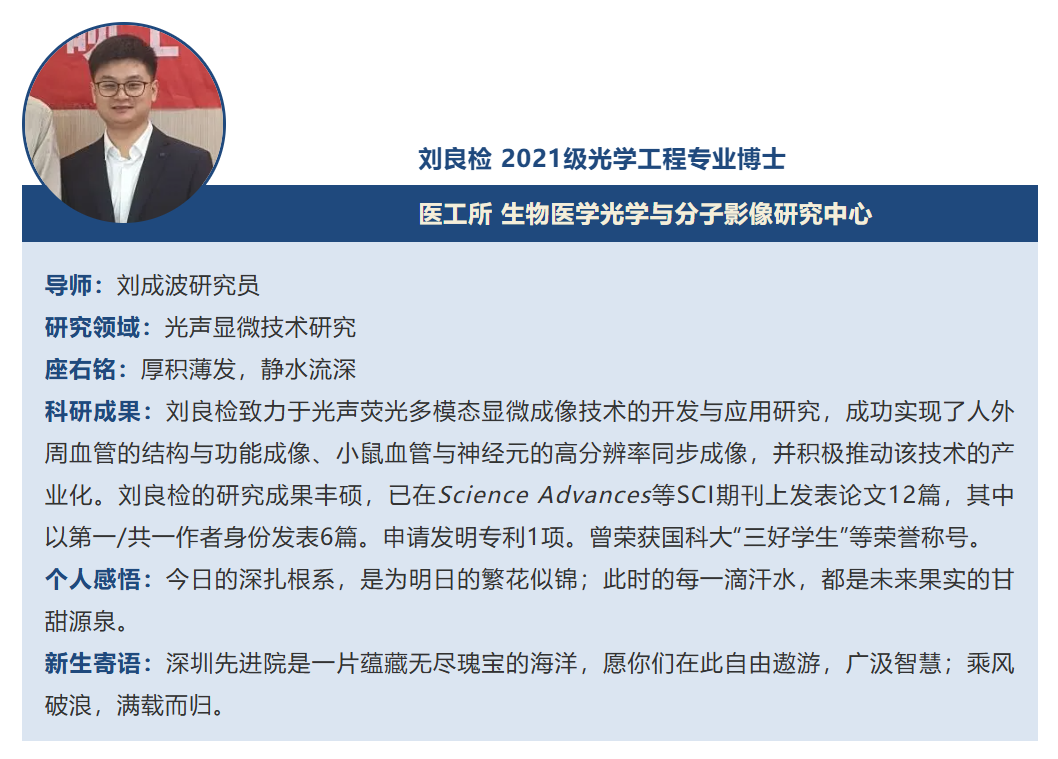Dr. Liu Liangjian's research focuses on high-speed, large-field-of-view photoacoustic/fluorescence multimodal microscopic imaging technology. Through technological innovations such as multi-faceted rotating mirrors and transducer arrays, he successfully developed a high-speed, large-field-of-view photoacoustic/fluorescence multimodal microscopic imaging instrument (LiTA-HM), overcoming the limitations of traditional multimodal systems where imaging field of view, resolution, and imaging speed constrain each other. This imaging system boasts a spatial resolution of 6 μm, an imaging field of view of 6 mm × 5 mm, and an imaging speed of 1.25 frames per second, enabling the real-time and synchronous acquisition of neuronal and vascular activity information across the entire cortex of mice.
As a co-first author, Dr. Liu Liangjian published the related research findings in the journal Science Advances, garnering recognition from international peers. Professor Junjie Yao, Deputy Editor of the journal and a professor at Duke University, USA, commented: "LiTA-HM integrates neural activity and vascular physiology into the same image, possessing spatial breadth and temporal precision, making it possible to decipher the most fundamental neurovascular collaborative mechanisms in the brain."
Based on the LiTA-HM system, Dr. Liu Liangjian's research team successfully conducted brain disease and brain function imaging experiments on awake mice, demonstrating the immense potential of this technology in brain science research and application. In a study on neurovascular coupling during epileptic seizures, the team successfully captured the propagation process of cortical spreading depression (SD) waves across the entire brain field of view in both neuronal and vascular networks. The study found that when SD waves propagated separately in the left and right brains, there were significant spatial and temporal correlations between neuronal calcium dynamics and cerebral vascular blood perfusion intensity fluctuations. This research provides a new approach for locating foci and predicting seizure timing in clinical epilepsy diagnosis and treatment.
During his studies, Dr. Liu Liangjian achieved abundant academic results. He published 12 papers in SCI-indexed journals, including 6 as first or co-first author, and applied for one invention patent.
On May 6, 2025, Dr. Liu Liangjian's doctoral dissertation, titled "High-speed, large-field-of-view photoacoustic microscopy imaging technology and its application in brain neurovascular coupling research," was unanimously passed by the defense committee with a "fully excellent" rating, and he was recommended for the award of a Doctor of Engineering degree. The defense committee consistently agreed that his research possessed both theoretical depth and practical value. In addition to recently receiving the Chinese Academy of Sciences President's Outstanding Award, Dr. Liu Liangjian has also been honored with awards such as the "Three Good Student" title from the University of Chinese Academy of Sciences (UCAS).
Dr. Liu Liangjian's research work represents cutting-edge exploration in the field of biomedical imaging. The high-speed, large-field-of-view photoacoustic/fluorescence multimodal microscopic imaging technology he developed not only breaks through the limitations of traditional imaging techniques by enabling synchronous observation of neural activity and vascular networks across the entire cerebral cortex but also provides a new tool for understanding brain (operating mechanisms). The future application prospects of this technology are vast. It could not only be used for high-speed imaging of the entire brain field of view in primates but also holds potential for non-invasive reading of brain function information, offering new paradigms and ideas for next-generation brain-computer interface technology.
